人教版(2019)选择性必修第三册 Unit 2 Healthy Lifestyle Reading and Thinking课件 (共29张PPT)
文档属性
| 名称 | 人教版(2019)选择性必修第三册 Unit 2 Healthy Lifestyle Reading and Thinking课件 (共29张PPT) | 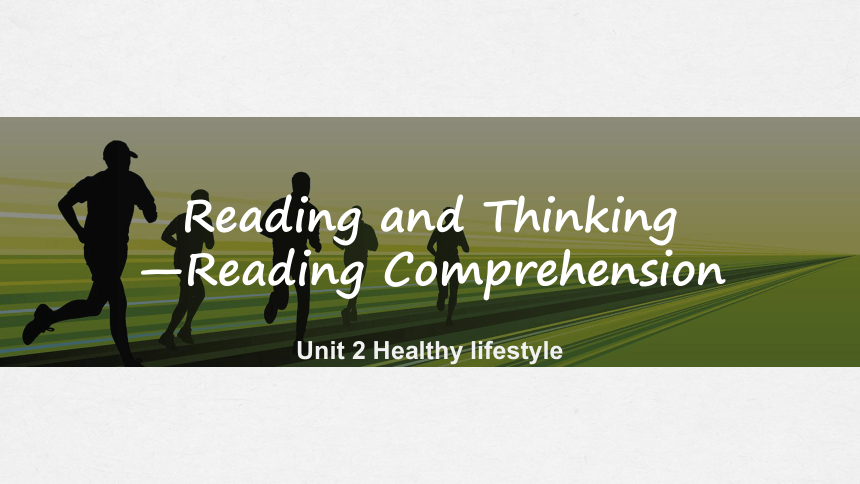 | |
| 格式 | pptx | ||
| 文件大小 | 14.1MB | ||
| 资源类型 | 教案 | ||
| 版本资源 | 人教版(2019) | ||
| 科目 | 英语 | ||
| 更新时间 | 2024-04-04 22:06:32 | ||
图片预览

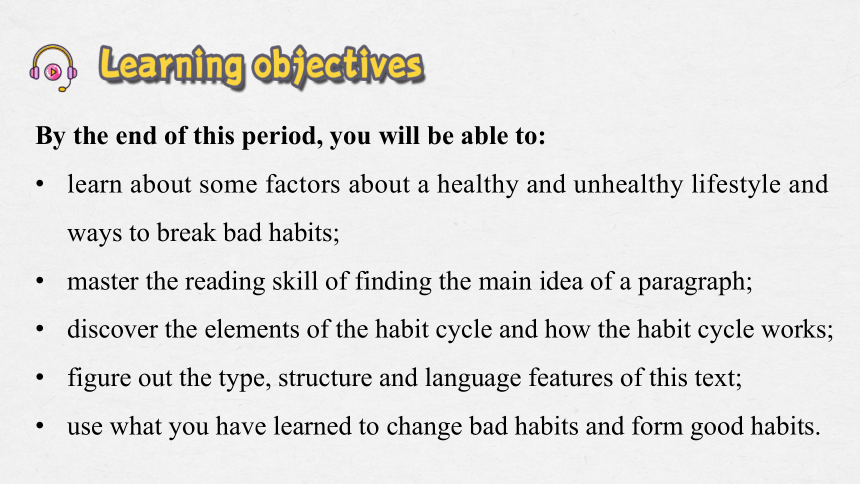
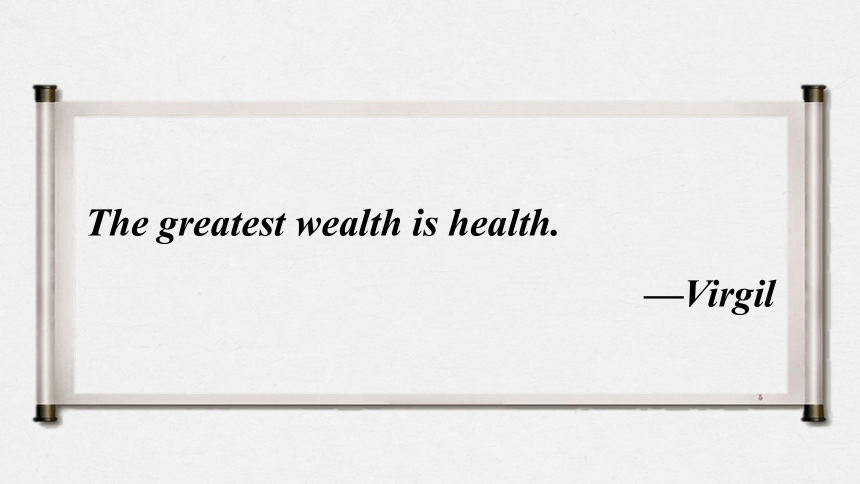
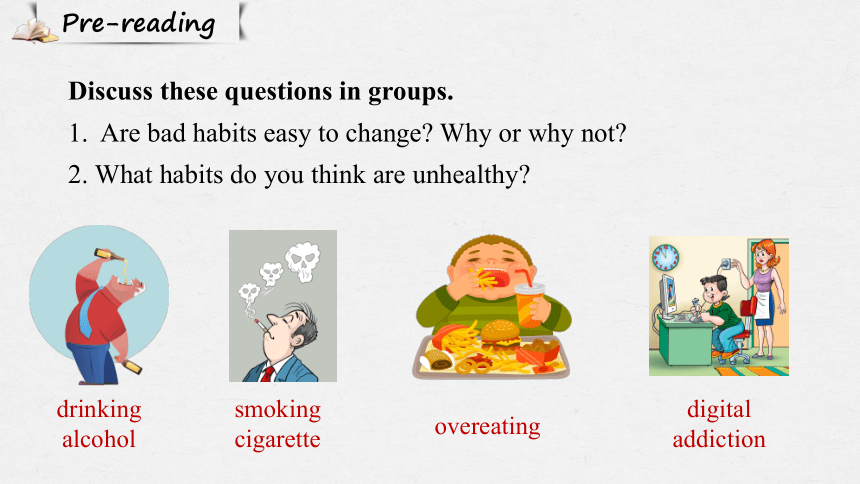

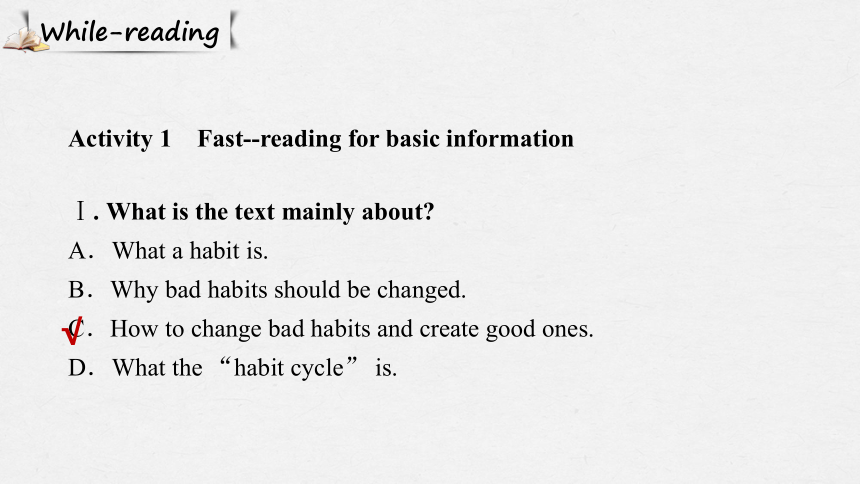
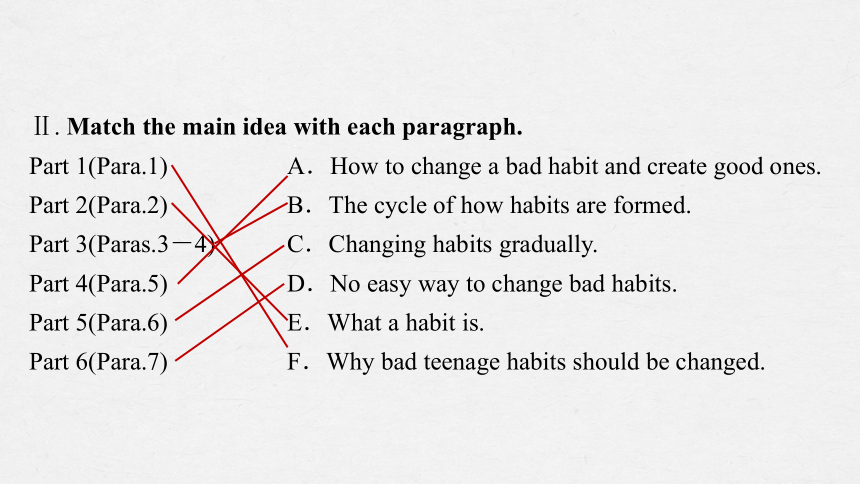
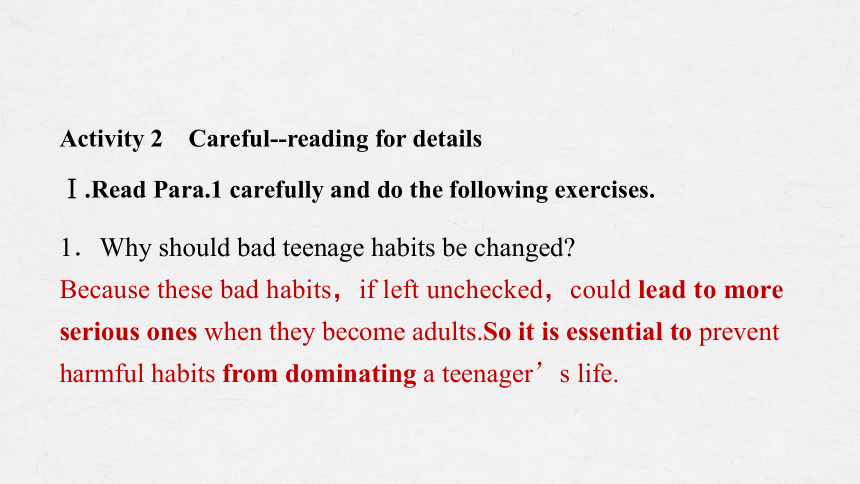

文档简介
(共29张PPT)
Reading and Thinking
—Reading Comprehension
Unit 2 Healthy lifestyle
By the end of this period, you will be able to:
learn about some factors about a healthy and unhealthy lifestyle and ways to break bad habits;
master the reading skill of finding the main idea of a paragraph;
discover the elements of the habit cycle and how the habit cycle works;
figure out the type, structure and language features of this text;
use what you have learned to change bad habits and form good habits.
The greatest wealth is health.
—Virgil
Pre-reading
Discuss these questions in groups.
1. Are bad habits easy to change Why or why not
2. What habits do you think are unhealthy
drinking alcohol
smoking
cigarette
overeating
digital addiction
3. What can you do to correct these bad habits
take more exercise
have a healthy diet
eat less junk food…
Let’s read the text to learn more about habits for healthy lifestyle.
While-reading
Activity 1 Fast- reading for basic information
Ⅰ. What is the text mainly about
A.What a habit is.
B.Why bad habits should be changed.
C.How to change bad habits and create good ones.
D.What the “habit cycle” is.
√
Ⅱ. Match the main idea with each paragraph.
Part 1(Para.1) A.How to change a bad habit and create good ones.
Part 2(Para.2) B.The cycle of how habits are formed.
Part 3(Paras.3-4) C.Changing habits gradually.
Part 4(Para.5) D.No easy way to change bad habits.
Part 5(Para.6) E.What a habit is.
Part 6(Para.7) F.Why bad teenage habits should be changed.
1.Why should bad teenage habits be changed
Because these bad habits,if left unchecked,could lead to more serious ones when they become adults.So it is essential to prevent harmful habits from dominating a teenager’s life.
Activity 2 Careful- reading for details
Ⅰ.Read Para.1 carefully and do the following exercises.
2.What should teenagers first do to prevent harmful habits from dominating their life
A.Stay away from bad habits.
B.Recognise bad habits.
C.Think out ways to get rid of them.
D.Change themselves.
√
3.How does the author develop this paragraph
A.By making comparisons.
B.By citing quotations.
C.By giving examples.
D.By listing numbers.
√
Ⅱ.Read Para.2 carefully and do the following exercises.
1.How can a choice lead to a habit
Actually,our lifestyle is the sum of choices we have made.We make a choice to do something and then we repeat it over and over again.Soon that choice becomes automatic and forms a habit that is much harder to change.
2.What characteristics does a habit have
Repetitive;automatic;harder to change.
3.What does the second paragraph mainly tell us
A.How we can get rid of bad habits.
B.How bad habits are formed.
C.How we can make a choice.
D.Why choices can become automatic.
√
4.We can change bad habits if we .
A.know about modern psychology
B.understand how habits work
C.take regular action
D.get reward from the routine
5.How does the author support his idea
A.By making comparisons.
B.By citing quotations.
C.By giving examples.
D.By listing numbers.
√
√
Ⅲ.Read Paras.3-4 carefully and do the following exercise.
1. What is the habit cycle
A.Routine→cue→reward.
B.Reward→cue→routine.
C.Cue→routine→reward.
D.Cue→reward→routine.
√
THE
HABIRT
CYCLE
2.How does the author further explain the “habit cycle”?
By _______________ in Para.4.
giving examples
Ⅳ.Read Paras.5-7 carefully and do the following exercises.
1.What do we do first to promote a positive change in bad habits
A.Adapt to bad habit cycles.
B.Listen to some of our favourite music.
C.Examine our bad habit cycles.
D.Replace a negative routine with a positive one.
2.How can we change our bad habits and create good habits
To begin with,we must examine our bad habit cycles,and then try to adapt them by combining the information from our habit cycles with something more positive.Aside from changing bad habits,we can also use the habit cycle to create good habits.
√
3.Fill in the chart.
The habit cycle Bad habit New habit
(1)___ feel unhappy feel unhappy
(2)_______ (4)_________________________ (6)__________________
__________________
(3)______ (5)___________________________ (7)____________
Cue
Routine
Reward
eat lots of unhealthy snacks
feel happy but it’s not healthy
listen to some of our favourite music
feel relaxed
4.How does the author develop Paragraph 5
A.By comparison.
B.By citing quotation.
C.By giving examples.
D.By listing numbers.
√
5.To change a bad habit,we need ________.
A.time B.discipline
C.repeated small steps D.all of above
√
6.What does “magic pill” in the last paragraph mean
A.A kind of medicine.
B.A pill eaten by a patient.
C.A way to solve all problems.
D.A medicine to cure all illnesses.
7.What do teenagers need to change bad habits
A.Immediate action.
B.Big goals.
C.Enough time.
D.Magic pill.
√
√
Ⅴ.Read the passage again and do the following exercises.
1.What can we infer from the passage
A.It is easy to change bad habits.
B.One step is enough for changing bad habits.
C.Changing bad habits is not easy.
D.Bad habits can disappear in a short time.
2.What kind of attitude does the author hold to changing bad habits
A.Negative. B.Sad.
C.Doubtful. D.Positive.
3.Who are the target audience of the text
Teenagers,especially those who want to change bad habits.
√
√
Post-reading
Activity 1 Discussion
1.Do you have any bad habits?If so,how can you change them
Yes,I have some bad habits,such as being addicted to playing computer games and being lazy.I want to change my bad habits,and form good ones.To change bad habits,I will first examine my bad habit cycles,replace a negative routine with something positive,and create good habits.Most importantly,I will make great efforts to change the situation.
2.Create a new habit cycle.
The habit cycle Bad habit New habit
Cue (1)______________ (4)____________
Routine (2)____________________ (5)____________________________________________
Reward (3)_______________________________ (6)_______________________
finished lunch
finish lunch
went to bed immediately
felt relaxed but it’s not healthy
go to the playground and walk for 10 minutes
feel relaxed and healthier
As teenagers grow up,they become more independent and start making their own decisions.However,during this period,it can be easy 1.___ some of them to form bad habits.These bad habits,if 2.____(leave) unchecked,could lead to more serious ones when they become adults.To change bad habits is never easy,even with many 3.________(attempt).The good news is that we can change our bad habits if we understand 4._____ habits work.To facilitate 5.___ positive change in our bad habits,we must first examine our bad habit cycles and then try to adapt them.
Activity 2 Summary
for
left
attempts
how
a
We can do this by 6._________(combine) the information from our habit cycles with our own positive ideas.We can also use the habit cycle 7._________(create) good habits.Many of us try to change bad habits quickly,and if we are not successful straight away,we often become pessimistic and give up.In fact,the most successful way to change is not suddenly,8.___ over a period of time.To reach the goal of change,a person must 9.__________(repeated) take many small steps.
Young people have the power to build a happy and 10._______(health) life full of good habits!
combining
to create
but
repeatedly
healthy
1.These bad habits,if left unchecked,could lead to more serious ones when they become adults.
[句式分析] 该句为____句。if引导的为____________的省略,if后面省略了________________;when引导________从句;短语lead to 意思是“___________”,to为_____。
[自主翻译]
Sentences analysis
复合
条件状语从句
they are
时间状语
导致,致使
介词
如果任其发展,在他们长大成人后,这些不良习惯可能会导致更为严重的有害习惯。
2.There is a famous saying based on the philosophy of Aristotle:“We are what we repeatedly do.”
[句式分析] 该句为____句。based on the philosophy of Aristotle为过去分词短语作________,修饰saying。引语“We are what we repeatedly do.”为_____句,what引导____从句,在从句中作____。
[自主翻译]
简单
后置定语
复合
表语
宾语
有一条基于亚里士多德哲学思想的著名谚语说道:“重复的行为造就了我们。”
3.The good news is that we can change,if we understand how habits work.
[句式分析] 该句为____句。that引导____从句;if引导________从句;how引导____从句。
[自主翻译]
复合
表语
条件状语
宾语
好消息是,如果我们了解习惯是怎么运作的,我们就可以作出改变。
4.For example,when we feel unhappy (cue),we eat lots of unhealthy snacks (routine),which makes us feel happy (reward).
[句式分析] 该句为____句。when引导________从句;which引导____________从句;feel happy是省略to的动词不定式作make的__________。
[自主翻译]
复合
时间状语
非限制性定语
宾语补足语
例如,当我们感到不高兴时(触发因素),我们会吃很多不健康零食(惯常行为),这让我们感到快乐(回报)。
Homework
Review what we have learnt and preview language points.
Reading and Thinking
—Reading Comprehension
Unit 2 Healthy lifestyle
By the end of this period, you will be able to:
learn about some factors about a healthy and unhealthy lifestyle and ways to break bad habits;
master the reading skill of finding the main idea of a paragraph;
discover the elements of the habit cycle and how the habit cycle works;
figure out the type, structure and language features of this text;
use what you have learned to change bad habits and form good habits.
The greatest wealth is health.
—Virgil
Pre-reading
Discuss these questions in groups.
1. Are bad habits easy to change Why or why not
2. What habits do you think are unhealthy
drinking alcohol
smoking
cigarette
overeating
digital addiction
3. What can you do to correct these bad habits
take more exercise
have a healthy diet
eat less junk food…
Let’s read the text to learn more about habits for healthy lifestyle.
While-reading
Activity 1 Fast- reading for basic information
Ⅰ. What is the text mainly about
A.What a habit is.
B.Why bad habits should be changed.
C.How to change bad habits and create good ones.
D.What the “habit cycle” is.
√
Ⅱ. Match the main idea with each paragraph.
Part 1(Para.1) A.How to change a bad habit and create good ones.
Part 2(Para.2) B.The cycle of how habits are formed.
Part 3(Paras.3-4) C.Changing habits gradually.
Part 4(Para.5) D.No easy way to change bad habits.
Part 5(Para.6) E.What a habit is.
Part 6(Para.7) F.Why bad teenage habits should be changed.
1.Why should bad teenage habits be changed
Because these bad habits,if left unchecked,could lead to more serious ones when they become adults.So it is essential to prevent harmful habits from dominating a teenager’s life.
Activity 2 Careful- reading for details
Ⅰ.Read Para.1 carefully and do the following exercises.
2.What should teenagers first do to prevent harmful habits from dominating their life
A.Stay away from bad habits.
B.Recognise bad habits.
C.Think out ways to get rid of them.
D.Change themselves.
√
3.How does the author develop this paragraph
A.By making comparisons.
B.By citing quotations.
C.By giving examples.
D.By listing numbers.
√
Ⅱ.Read Para.2 carefully and do the following exercises.
1.How can a choice lead to a habit
Actually,our lifestyle is the sum of choices we have made.We make a choice to do something and then we repeat it over and over again.Soon that choice becomes automatic and forms a habit that is much harder to change.
2.What characteristics does a habit have
Repetitive;automatic;harder to change.
3.What does the second paragraph mainly tell us
A.How we can get rid of bad habits.
B.How bad habits are formed.
C.How we can make a choice.
D.Why choices can become automatic.
√
4.We can change bad habits if we .
A.know about modern psychology
B.understand how habits work
C.take regular action
D.get reward from the routine
5.How does the author support his idea
A.By making comparisons.
B.By citing quotations.
C.By giving examples.
D.By listing numbers.
√
√
Ⅲ.Read Paras.3-4 carefully and do the following exercise.
1. What is the habit cycle
A.Routine→cue→reward.
B.Reward→cue→routine.
C.Cue→routine→reward.
D.Cue→reward→routine.
√
THE
HABIRT
CYCLE
2.How does the author further explain the “habit cycle”?
By _______________ in Para.4.
giving examples
Ⅳ.Read Paras.5-7 carefully and do the following exercises.
1.What do we do first to promote a positive change in bad habits
A.Adapt to bad habit cycles.
B.Listen to some of our favourite music.
C.Examine our bad habit cycles.
D.Replace a negative routine with a positive one.
2.How can we change our bad habits and create good habits
To begin with,we must examine our bad habit cycles,and then try to adapt them by combining the information from our habit cycles with something more positive.Aside from changing bad habits,we can also use the habit cycle to create good habits.
√
3.Fill in the chart.
The habit cycle Bad habit New habit
(1)___ feel unhappy feel unhappy
(2)_______ (4)_________________________ (6)__________________
__________________
(3)______ (5)___________________________ (7)____________
Cue
Routine
Reward
eat lots of unhealthy snacks
feel happy but it’s not healthy
listen to some of our favourite music
feel relaxed
4.How does the author develop Paragraph 5
A.By comparison.
B.By citing quotation.
C.By giving examples.
D.By listing numbers.
√
5.To change a bad habit,we need ________.
A.time B.discipline
C.repeated small steps D.all of above
√
6.What does “magic pill” in the last paragraph mean
A.A kind of medicine.
B.A pill eaten by a patient.
C.A way to solve all problems.
D.A medicine to cure all illnesses.
7.What do teenagers need to change bad habits
A.Immediate action.
B.Big goals.
C.Enough time.
D.Magic pill.
√
√
Ⅴ.Read the passage again and do the following exercises.
1.What can we infer from the passage
A.It is easy to change bad habits.
B.One step is enough for changing bad habits.
C.Changing bad habits is not easy.
D.Bad habits can disappear in a short time.
2.What kind of attitude does the author hold to changing bad habits
A.Negative. B.Sad.
C.Doubtful. D.Positive.
3.Who are the target audience of the text
Teenagers,especially those who want to change bad habits.
√
√
Post-reading
Activity 1 Discussion
1.Do you have any bad habits?If so,how can you change them
Yes,I have some bad habits,such as being addicted to playing computer games and being lazy.I want to change my bad habits,and form good ones.To change bad habits,I will first examine my bad habit cycles,replace a negative routine with something positive,and create good habits.Most importantly,I will make great efforts to change the situation.
2.Create a new habit cycle.
The habit cycle Bad habit New habit
Cue (1)______________ (4)____________
Routine (2)____________________ (5)____________________________________________
Reward (3)_______________________________ (6)_______________________
finished lunch
finish lunch
went to bed immediately
felt relaxed but it’s not healthy
go to the playground and walk for 10 minutes
feel relaxed and healthier
As teenagers grow up,they become more independent and start making their own decisions.However,during this period,it can be easy 1.___ some of them to form bad habits.These bad habits,if 2.____(leave) unchecked,could lead to more serious ones when they become adults.To change bad habits is never easy,even with many 3.________(attempt).The good news is that we can change our bad habits if we understand 4._____ habits work.To facilitate 5.___ positive change in our bad habits,we must first examine our bad habit cycles and then try to adapt them.
Activity 2 Summary
for
left
attempts
how
a
We can do this by 6._________(combine) the information from our habit cycles with our own positive ideas.We can also use the habit cycle 7._________(create) good habits.Many of us try to change bad habits quickly,and if we are not successful straight away,we often become pessimistic and give up.In fact,the most successful way to change is not suddenly,8.___ over a period of time.To reach the goal of change,a person must 9.__________(repeated) take many small steps.
Young people have the power to build a happy and 10._______(health) life full of good habits!
combining
to create
but
repeatedly
healthy
1.These bad habits,if left unchecked,could lead to more serious ones when they become adults.
[句式分析] 该句为____句。if引导的为____________的省略,if后面省略了________________;when引导________从句;短语lead to 意思是“___________”,to为_____。
[自主翻译]
Sentences analysis
复合
条件状语从句
they are
时间状语
导致,致使
介词
如果任其发展,在他们长大成人后,这些不良习惯可能会导致更为严重的有害习惯。
2.There is a famous saying based on the philosophy of Aristotle:“We are what we repeatedly do.”
[句式分析] 该句为____句。based on the philosophy of Aristotle为过去分词短语作________,修饰saying。引语“We are what we repeatedly do.”为_____句,what引导____从句,在从句中作____。
[自主翻译]
简单
后置定语
复合
表语
宾语
有一条基于亚里士多德哲学思想的著名谚语说道:“重复的行为造就了我们。”
3.The good news is that we can change,if we understand how habits work.
[句式分析] 该句为____句。that引导____从句;if引导________从句;how引导____从句。
[自主翻译]
复合
表语
条件状语
宾语
好消息是,如果我们了解习惯是怎么运作的,我们就可以作出改变。
4.For example,when we feel unhappy (cue),we eat lots of unhealthy snacks (routine),which makes us feel happy (reward).
[句式分析] 该句为____句。when引导________从句;which引导____________从句;feel happy是省略to的动词不定式作make的__________。
[自主翻译]
复合
时间状语
非限制性定语
宾语补足语
例如,当我们感到不高兴时(触发因素),我们会吃很多不健康零食(惯常行为),这让我们感到快乐(回报)。
Homework
Review what we have learnt and preview language points.
